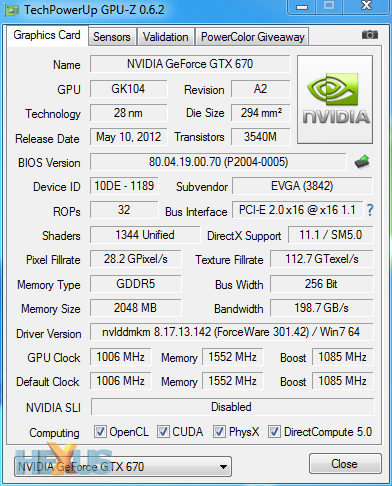Test Methodology
EVGA GeForce GTX 670 FTW specification |
|---|
 |
GPU comparisons |
|||||||
|---|---|---|---|---|---|---|---|
| Graphics card | GPU base clock (MHz) |
Processors | Shader clock (MHz) |
Memory clock (MHz) |
Memory bus (bits) |
Graphics driver | |
| NVIDIA GeForce GTX 690 (4,096MB) | 915 | 3,072 | 915 | 6,008 | 256 x 2 | ForceWare 301.33 | |
| NVIDIA GeForce GTX 680 (2,048MB) | 1,006 | 1,536 | 1,006 | 6,008 | 256 | ForceWare 301.33 | |
| ASUS GeForce GTX 670 Direct CU II TOP (2,048MB) | 1,058 | 1,344 | 1,058 | 6,008 | 256 | ForceWare 301.42 | |
| EVGA GeForce GTX 670 FTW (2,048MB) | 1,006 | 1,344 | 1,006 | 6,208 | 256 | ForceWare 301.42 | |
| NVIDIA GeForce GTX 670 (2,048MB) | 915 | 1,344 | 915 | 6,008 | 256 | ForceWare 301.33 | |
| AMD Radeon HD 7970 (3,072MB) | 925 | 2,048 | 925 | 5,500 | 384 | Catalyst 12.4 | |
| AMD Radeon HD 7950 (3,072MB) | 800 | 1,792 | 800 | 5,000 | 384 | Catalyst 12.4 | |
HEXUS high-end test bench |
||||||||||||
|---|---|---|---|---|---|---|---|---|---|---|---|---|
| Processor | Intel Core i5-2500K (3.30GHz, 6MB smart cache, quad-core, LGA1155) | |||||||||||
| Motherboard | Intel Desktop Board DP67BG | |||||||||||
| Memory | 8GB Corsair Vengeance (9-9-9-24 @ 1,600MHz) | |||||||||||
| Power Supply | Corsair AX750W | |||||||||||
| Monitor | Dell 30in 3007WFP | |||||||||||
| Disk drive(s) | Crucial RealSSD C300 (256GB) | |||||||||||
| Chassis | Corsair Graphite Series 600T | |||||||||||
| Operating system | Windows 7 Ultimate (64-bit, SP1) | |||||||||||
HEXUS high-end benchmark suite |
||||||||||||
|---|---|---|---|---|---|---|---|---|---|---|---|---|
| Aliens vs. Predator | DX11, 1,920x1,080 and 2,560x1,600 resolutions, 4xAA, 16xAF, very high quality | |||||||||||
| Battlefield 3 | DX11, 1,920x1,080 and 2,560x1,600 resolutions, 4xMSAA, 16xAF, ultra quality | |||||||||||
| Batman: Arkham City | DX11, 1,920x1,080 and 2,560x1,600 resolutions, 8xMSAA, extreme quality | |||||||||||
| Crysis 2 | DX11, 1,920x1,080 and 2,560x1,600 resolutions, 4xAA, ultra quality | |||||||||||
| Just Cause 2 | DX10, 1,920x1,080 and 2,560x1,600 resolutions, 4xAA, 16xAF, very high quality | |||||||||||
| Total War: Shogun 2 | DX11, 1,920x1,080 and 2,560x1,600 resolutions, 4xMSAA, 16xAF, high quality | |||||||||||
| Power Consumption | To emulate real-world usage scenarios, we record mains power draw both when idle and whilst playing Batman: Arkham City | |||||||||||
| Temperature | To emulate real-world usage scenarios, we record GPU core temperature both when idle and whilst playing Batman: Arkham City | |||||||||||
| Noise | A PCE-318 meter is used to record noise levels when idle and whilst playing Batman: Arkham City | |||||||||||
| Overclocking | Pushing the graphics card as far as it will go, we increase speeds and re-run the Crysis 2 benchmark | |||||||||||
Notes
We know everything there is to know about the reference GeForce GTX 670, so the purpose of this review is simple; we're putting two of the best factory-overclocked GTX 670s head-to-head to see who comes out on top.
In one corner there's ASUS's GTX 670 DirectCU II TOP, running with a 1,058MHz core, 6,008MHz memory and a custom dual-fan cooler. In the other corner, EVGA's GTX 670 FTW has a 1,006MHz core, 6,208MHz memory and a cooler taken from the GeForce GTX 680. Both cards are evenly matched and available at around £350, so let the contest begin.









